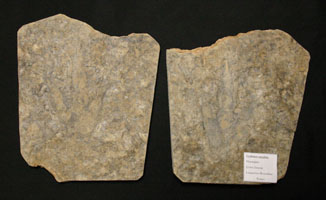The study of fossilized footprints, Ichnology, has become an important branch of paleontology. Footprints are trace fossils. They are considered trace fossils because they contain no fossil material, only the impressions left by the animal which made them. It is often difficult to determinte with certainty which animal made a given print and therefore they are usually attributed to a group rather than a specific animal.
Grallator is an ichnogenus, meanig it is a genus which is represented by only footprints. There are no fossil remains which have been identified as belonging to this animal. Grallator means "stilt walker," but since no fossil remains have been found, they don't know how long its legs were. The prefix "Grallae" refers to the bird group that includes herons and storks (long legged wading birds). It is likely that Grallator variabilis resembled a Coelophysis.
Grallator footprints are found in Canada, the north-east coast of the United States, and Europe. Their footprints are three toed and are usually two to six inches long. Their discoverer, Edward Hitchcock, gave the name Grallator in 1858. The slates and shale of southern France, where this track is from, probably represents low lying areas or very shallow tidal expanses.
Grallator was a theropod and as such, theropod attributes were assigned to it. It is considered to be a carnivore and to have reproduced by laying eggs. It was most likely a solitary animal since Grallator track ways are ususlly those of a single animal.
We are fortunate to have both sides of this track. The impression and the natural cast. A natural cast is the infilling or overlay of an original impression by sediments. A natural cast is also sometimes called a positive and the impression is sometimes called a negative.
These specimens are being offered from a private collection!
Grallator variabilis 
Quantity in Basket: None
Code: OCF-310
Price: $1,100.00
Shipping Weight: 10.00 pounds
Time: Lower Jurassic, Hettangian Stage approximately 195 million years ago.
Location: Languedoc, Roussillon, France
Dimensions: Positive: 9-1/2" x 8" x 1/2", negative: 9" x 8-1/2" x 3/4"